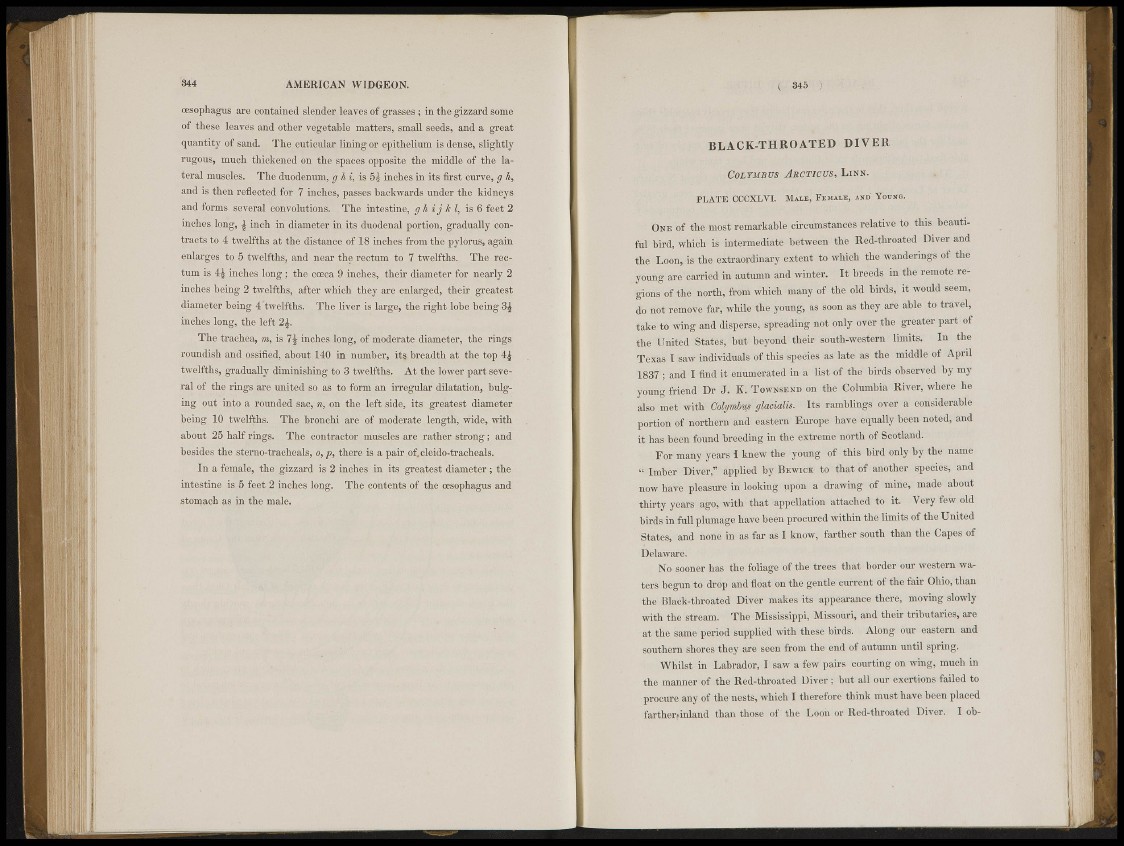
344 AMERICAN WIDGEON.
oesophagus are contained slender leavesbf grasses ; in the gizzard some
these, leayës a n | other vegetable matters, small seeds, and a great
quantity|m!saiid. The cuticular lining or epithelium is dense, slightly
rufous, much thickened on fhiè spaces opposite the middle of the lateral
muscles. The duodenum, g h i, is inches in its first curve, g h,
Jjflàd is then reflected for 7 inches, passes backwards under the kidneys
and forms several Convolutions, The intestine, g h i j k I, is 6 feet 2
inches long, | inch in diameter in its duodenal portion, gradually contracts
to 4 twelfths at the distance of 18 inches from the pylorus, again
enlarges ty 5 twelfths, and near the rectum to % twelfths. The rectum
is 4J inches long ; the eoeca 9 inches, their diameter for nearly 2
inches being 2 twelfths, after which they are enlarged, their greatest
diameter being ("twelfths. The liver is largo, the right lobe being 3^
inches long, the left
The trachea, is inches long, of moderate diameter, the rings
roundish and ossified, about 140 ill number, itj. breadth at the top 4£
twelfths, gradually diminishing to 3 twelfths. At the lower part several
of the rings are united so as to form an irregular dilatation, bulging
out into a rounded sac, n, on the left side, its greatest diameter
being] ÎÉ) twelfths. The bronchi are of moderate. length, wide, with
about 25 half rings. The contractor muscles are rather strong ; and
besides the sterno tracheal-!, o, p, there is a pair of.cleido-traclicals.
In a female, the, gizzard is 2 inches in its. greatest diameter ; the
intestine! is 5 leet 2 inches long. The contents of the oesophagus and
stomach as in the male,
( 345 §
B L A C K - f c H R O A T E D DIVER
COL Y M /Î US ABCTICZTS, LINN,
PLATE (X'lXI.VI. MALE, FEMALE, AXD Yonso.
On h 'of t i e most remarkable circumstances relative to this beautiful
bird, which is intermediate between the Red-throated Diver and
the ®,ffon,4s the extraordinary extent to which the wanderings of the
young are carried Wauuimri and winter. It breeds i n the remote regions
of the north, from which many of the old birds, M would seem,
®3 not remove fai; while the young, as soon as thoy are able to travel,
take to wing and disperse, spreading not only over tlio. greater part of
the United StàtëSi bi t beyond their ®uth-western limits. In the
Texas Tsaw individuals of this spccies as late as the middle of April
1837 ; and I finftSt enumerated in a list of the birds observed by my
young friend Dr d?l!i;K. TOWS SEND on the Columbia River, where he
also met with Cu!i/mt,v? glaoia/is. Its rambling* over à considerable:
portion of northern and eastern Europe have equally been noted, and
it Has been found breeding m the extreme north of Scotland.
. -For many years i knew the young of this bird only by the name
« Imb.-r Diver," applied by BEWICK to that bf another species, and
now have, pleasure in looking upon a drawings«® mine, made ¡about
thirty years ago, with that appellation attached to it. Very few old
birds in full plumage have been procured within the limits of the United
States, and none in as far as I know, farther south than the Capes of
Delaware.
No sooner has the foliage of the trees that border our western water*
begun to drop and float on the gentle current of the fair Ohio, than
the Black-throated Diver makes its appearance there, moving slowly
with the stream. The Mississippi, Missouri, and their tributaries, are
at the same period supplied with these birds. Along our eastern and
•soiithenl shores they are seen from the end of autumn until spring.
Whilst in Labrador,-1' saw a tow pairs courting on -wing, much in
the manner of the Red-throated Diver ; but all our exertions failed to
procure any of the'nests, which I therefore think must have been placed
faïtherfinland than those of the Loon or Red-throated Diver. I ob